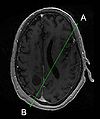2011 Summer Project Week Intraoperative Brain Shift Monitor
Intraoperative Brain Shift Monitor
Key Investigators
- BWH/HMS: Jason White, Alex Golby, and Steve Pieper
Objective
Real-time ultrasound data is used to track the shifting of intracranial anatomy during neurosurgery. This is accomplished with a stationary ultrasound probe that is mounted away from the surgical site, and operates transcranially so as to be completely unobtrusive to surgical activities. Coordinating the use of this device with Slicer and BrainLab:
- Registering the data obtained from it with pre-op images (MRI, CT, etc.) (Fig. 1)
- Using this data to modify/deform the pre-op images in order to maintain a more accurate representation of intraoperative anatomy.
Approach, Plan
Progress
One-dimensional object-tracking data generated by the ITUM was ported to Slicer via IGTLink. Both the data and its associated spatial transform was transferred and displayed at a high temporal resolution (for this application, "high temporal resolution" is approximately 6 Hz).
References
P.J. White, S. Whalen, S.C. Tang, G.T. Clement, F.A. Jolesz, and A. Golby, “An Intraoperative Brain-shift Monitor Using Shear-mode Transcranial Ultrasound: Preliminary Results” Journal of Ultrasound in Medicine 2009; 28 191-203.



